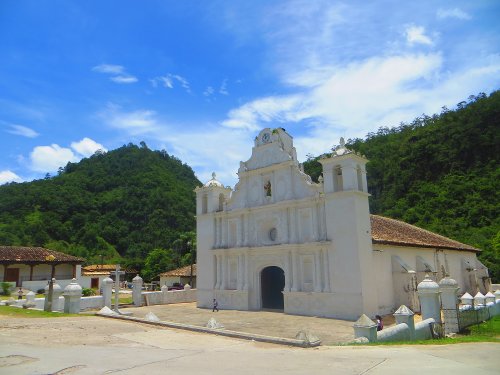Sights and Activities
Below are the places we saw and activities completed while visiting Honduras:
Tegucigalpa
Santa Lucia: we went out in the evening to have some drinks in this charming old colonial town with spectacular views over the capital.
Cerro Picacho: Picacho Hill offers great views of the city and also has the city’s version of a Christ statue.
Museo para la Identidad Nacional: this museum, Musem for the National Identity, contained a couple of temporary exhibits with modern art and a permanent exhibition with a comprehensive overview of the country’s history and identity.
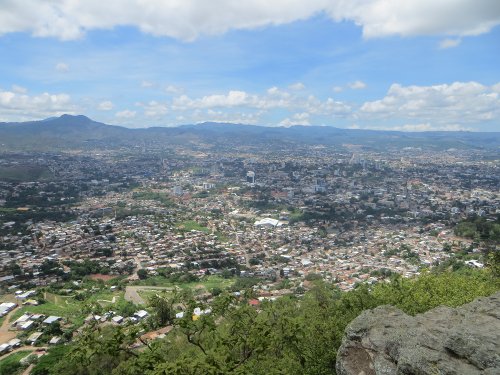
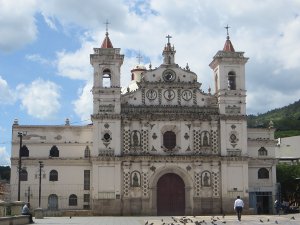
Plaza Morazan: this plaza, also known as Parque Central (Central Park), is in the heart of the city features a statue of former president Francisco Morazán on horseback. Overlooking the square is the city’s 18th century cathedral, which we entered.
Iglesia Los Dolores: this 18th century baroque church was closed, but we were able to appreciate the exterior details.
Ojojona: this charming small colonial town located 34 km (21 miles) south of Tegucigalpa was founded in 1579 by Spanish miners who worked the silver and gold mines of the area.

Basilica de Suyapa: this huge gothic church is considered the most important in the country. Located on a hillside, the basilica has brilliant stained-glass windows and dates back to 1954. The interior houses a small wooden statue of La Virgen de Suyapa (The Virgin of Suyapa).

Utila
Whale Shark & Oceanic Research Center: we were able to learn about whale sharks in this research center. Even though they are considered ‘vunerable’ by the International Union for Conservation of Nature, these large fish are said to be stable around Utila.
Iguana Research & Breeding Station: this center studies and protects the highly endangered Utila iguana (swamper). We saw several iguanas of different ages and learned how they are trying to educate the locals that they should not be eaten.


Chepes Beach: the island is better known for its diving than its beaches, but this place is a pleasant, white sand beach to relax for a couple hours.
Whale Shark Tour: we decided to take the tour with the Whale Shark & Oceanic Research Center to support their cause. We spent four hours at sea, but unfortunately did not spot any whale sharks. We were able to snorkel at a reef and learn about various fish and coral from the volunteers that usually have a marine biology or biology background.
San Pedro Sula
Catedral de San Pedro: located in the city’s main plaza, Parque Central (Central Park), this cathedral imitates colonial design, but actually was built in 1949.
Reserva de El Merendon: this reserve is one of Central America’s first protected area. We woke up early to hike along the 2km long, Coca Cola trail, named after the Coca Cola sign that you find at the top. We arrived at the end of the trail to not only see the sign, but also a splendid view of the city.
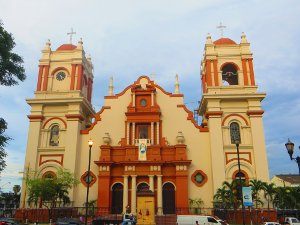

Lago de Yojoa
Boat Tour: we enjoyed a 45-minute boat ride at one end of the large Lake Yojoa. The lake is home to several bird species that we were able to witness on the ride and throughout our time we spent in the surroundings.
Pulhapanzak Waterfall: this magnificent 43m (141 ft) waterfall is located 17km (10.6 miles) north of the lake. After a short hike to see the falls, we returned up river to take a dip in a swimming hole.
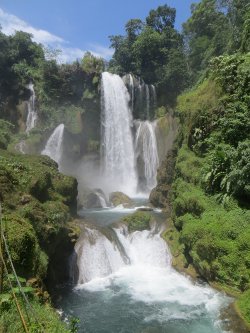
Boat Ride in Lago de Yojoa
Parque Eco-Arqueologico Los Naranjos: this area was first occupied around 1300 BC and is thought to be the largest Preclassic-era Lenca archaeological site. We hiked through the park’s trails viewing semi-excavated ruins amongst a forested jungle.

San Isidro
We spent over a week WWOOFing near the village of San Isidro in a coffee and cocoa farm. The farm also had several other crops such as oranges, avocados, bananas, and much more. It also had a forest reserve with a couple of trails and full of flora and fauna. It was common to see various exotic birds at any time of the day. Our work at the farm was mainly weeding and yardwork, but we were fortunate to learn and witness the entire process of making chocolate, from harvesting the pods and removing the seeds from the fruit to toasting and grinding the seeds. Be sure to read our article to learn more about this unique experience.
Puerto Cortes

Coca Cola Beach: this city is the country’s main port and therefore, like many port cities, not very attractive, but Sal has family that lives there and they were able to take us to this nice long stretch of sand. The beach is in front of a Coca Cola factory, hence the name. The beach is good for a swim or a stroll on the long promenade.
Fortaleza de San Fernando de Omoa: Omoa is the neighboring city and home to this large fort. The colossal Spanish fortress was built of brick and coral between 1759 and 1777 under orders from King Fernando VII of Spain to protect the coast from rampant piracy. The fortress was captured in 1779 by the British. Today it hosts a museum and views of the neighboring bay.

Copan Ruinas
Mirador El Cuartel: this former jail now serves as a fine lookout of the town.
Museo de Arqueologia Maya: this archaeological museum houses exhibits on Mayan culture and history, and displays ceramics, sculptures, and artwork found in the area.
Museo Digital de Copan: this very interesting museum presents photographs of Copan while being excavated, tells the history of the city and how it has developed, shows a 3-d video of the ruins, and let’s you play a traditional Mayan game called Patolli. The museum was a gift to the people of Copan from Japan.
The Tea and Chocolate Place: this oasis is the project of David Sedat, a US archaeologist, who led the team that discovered the tomb of Yax K’uk Mo’, the founder of Copan’s ruling dynasty, in 1995. His second passion has been the environment and, with the help of his family, have dedicated to the reforestation and the sustainable cultivation of various fruit trees, crops, and medicinal plants on the hills of Copan. This location is the family residence where they have allocated a space for a store and café where they sell their organic products. They provide samples of many of their products, we were able to try some of their noni juice, a fruit known for its health properties. This was one of many juices and teas they had available for purchase. We continued to enjoy the lovely ambience by ordering a hot chocolate and contributing to the inspirational cause.
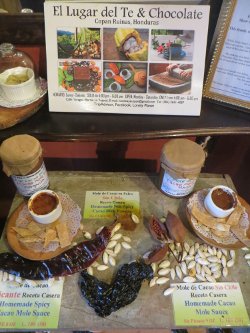
Copan Archaeological Site: this Unesco World Heritage Site is one of the most important of all Maya civilizations. This site and its people thrived in the time known as the Classic period (AD 250 -900), then mysteriously crumbled. The most remarkable creation at this site were their sculptures and hieroglyphics. We took a guided tour of the complex admiring the incredible construction and detailed productions. The Great Plaza houses amazing carved stelaes portraying the rulers of Copan. It is believed that originally, they were painted, which archaeologists found some with paint. Some of the stelaes found in the plaza are understandably reproductions, but the originals are displayed in the museum. Around AD 426, Copan was ruled by K’inich Yax K’uk’ Mo’ (Great Sun Lord Quetzal Macaw). Archaeologists believe he was a great shaman and warrior, as hieroglyphic evidence indicates that 16 later kings revered him as the semidivine founder of the city. His dynasty ruled throughout Copan’s golden age.

Museo de Escultura: this Sculpture Museum, located inside the Copan Archaeological Site, displays fine examples of the Mayan world. The museum contains many replicas and original sculptures, but the highlight is a full-scale copy of the Rosalia temple, which was discovered in near-perfect condition by archaeologists in 1989 by digging a tunnel in one of the temples. The discovered temple was believed to be so sacred that it was left completely intact inside the newer structure. The replica displays some vibrant colors that makes you want to transport yourself to the prime days of when this amazing civilation thrived.
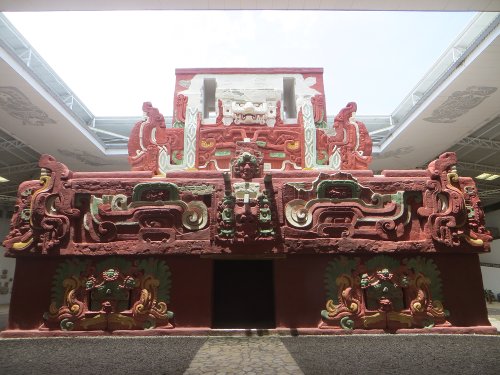
Gracias
Parque Central: the towns Central Park, is home to three churches, Iglesia San Marcos Church, Iglesia de la La Merced, and Iglesia San Sebastian.
Castillo San Cristobal: this small hillside fort overlooks the town and surroundings with great views. The fort dates back to the 19th century.
Aguas Termales Presidente: we walked approximately 5km (3.1 miles), which took about an hour in the late afternoon to arrive to these natural springs. We enjoyed a couple of evening hours of warm thermal waters in their five pools surrounded by forest.
La Campa: we took a brief visit to this lovely village not too far from Garcias that is surrounded by towering mountains and a spectacular canyon. There were a few ceramic shops and a small church with an impressive mountainous backdrop.

